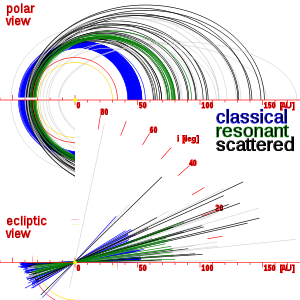- Scattered disk objects
-
Scattered disk objects (SDO, auch Scattered Kuiper Belt Objects, SKBO) sind Transneptunische Objekte des Kuipergürtels. Sie befinden sich außerhalb des Neptun-Einflussbereichs, d. h. der Neptun hat nur geringe Auswirkungen auf ihre Bahn.
Inhaltsverzeichnis
Entstehung
Sie sind vermutlich in der Umgebung der Äußeren Planeten Jupiter, Saturn, Uranus und Neptun entstanden und durch die Gravitationswechselwirkung mit diesen Planeten in die äußeren Bereiche des Sonnensystems gestreut worden. Neuere Untersuchungen deuten darauf hin, dass dieser Vorgang etwa 650 Millionen Jahre nach der Entstehung des Sonnensystems stattfand und eng mit dem Late Heavy Bombardement zusammenhängt.
Bekannte Vertreter
Das größte bekannte SDO ist der Zwergplanet Eris. Das Objekt hat einen Mond und befindet sich momentan in einer Entfernung von 97 AE (14,6 Milliarden km). Eris bewegt sich auf einer stark exzentrischen und geneigten Bahn, die es in eine Apheldistanz von fast 100 AE führt.
Bei einem anderen Vertreter der SDOs, dem Asteroiden 2000 OO67, ist die Umlaufbahn sogar so exzentrisch, dass sein Perihel innerhalb der Bahn des Neptun und sein Aphel in über 1000 AE Entfernung von der Sonne liegt.
Weitere bekannte SDOs:
- 1995 TL8
- 1996 TL66, erstes entdecktes SDO
- 2004 XR190
Literatur
- Alessandro Morbidelli: Origin and Dynamical Evolution of Comets and their Reservoirs (Lectures on comets dynamics and outer solar system formation), 2005 (pdf)
Weblinks
Wikimedia Foundation.

